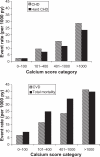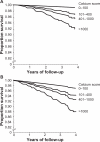Cardiac risk stratification: role of the coronary calcium score
- PMID: 20730016
- PMCID: PMC2922321
- DOI: 10.2147/vhrm.s8753
Cardiac risk stratification: role of the coronary calcium score
Abstract
Coronary artery calcium (CAC) is an integral part of atherosclerotic coronary heart disease (CHD). CHD is the leading cause of death in industrialized nations and there is a constant effort to develop preventative strategies. The emphasis is on risk stratification and primary risk prevention in asymptomatic patients to decrease cardiovascular mortality and morbidity. The Framingham Risk Score predicts CHD events only moderately well where family history is not included as a risk factor. There has been an exploration for new tests for better risk stratification and risk factor modification. While the Framingham Risk Score, European Systematic Coronary Risk Evaluation Project, and European Prospective Cardiovascular Munster study remain excellent tools for risk factor modification, the CAC score may have additional benefit in risk assessment. There have been several studies supporting the role of CAC score for prediction of myocardial infarction and cardiovascular mortality. It has been shown to have great scope in risk stratification of asymptomatic patients in the emergency room. Additionally, it may help in assessment of progression or regression of coronary artery disease. Furthermore, the CAC score may help differentiate ischemic from nonischemic cardiomyopathy.
Keywords: CAC; Framingham; angiography; cardiomyopathy; chest pain; coronary artery disease; coronary calcium scoring; risk factors; risk stratification.
Figures




Similar articles
-
Utility of coronary artery calcium scoring in the evaluation of patients with chest pain.Crit Pathw Cardiol. 2012 Sep;11(3):99-106. doi: 10.1097/HPC.0b013e31825b1429. Crit Pathw Cardiol. 2012. PMID: 22825529 Review.
-
Comprehensive coronary risk determination in primary prevention: an imaging and clinical based definition combining computed tomographic coronary artery calcium score and national cholesterol education program risk score.Int J Cardiol. 2006 Jun 16;110(2):129-36. doi: 10.1016/j.ijcard.2005.09.009. Epub 2005 Nov 21. Int J Cardiol. 2006. PMID: 16303191 Review.
-
Thoracic aortic calcium versus coronary artery calcium for the prediction of coronary heart disease and cardiovascular disease events.JACC Cardiovasc Imaging. 2009 Mar;2(3):319-26. doi: 10.1016/j.jcmg.2008.12.010. JACC Cardiovasc Imaging. 2009. PMID: 19356578
-
Differentiation of severe coronary artery calcification in the Multi-Ethnic Study of Atherosclerosis.Atherosclerosis. 2011 Dec;219(2):616-22. doi: 10.1016/j.atherosclerosis.2011.08.038. Epub 2011 Aug 31. Atherosclerosis. 2011. PMID: 21930271
-
Computed Tomography for Coronary Artery Calcification Scoring: Mammogram for the Heart.Prog Cardiovasc Dis. 2016 Mar-Apr;58(5):529-36. doi: 10.1016/j.pcad.2016.01.007. Epub 2016 Feb 15. Prog Cardiovasc Dis. 2016. PMID: 26892393 Review.
Cited by
-
Correlation between serum parathyroid hormone levels and coronary artery calcification in patients without renal failure.Biomed Rep. 2016 Nov;5(5):601-606. doi: 10.3892/br.2016.761. Epub 2016 Sep 26. Biomed Rep. 2016. PMID: 27882224 Free PMC article.
-
The Use of Primary Prevention Statin Therapy in Those Predisposed to Atherosclerosis.Curr Atheroscler Rep. 2017 Oct 17;19(12):48. doi: 10.1007/s11883-017-0685-7. Curr Atheroscler Rep. 2017. PMID: 29038899 Review.
-
The Role of Imaging in Health Screening: Screening for Specific Conditions.Acad Radiol. 2021 Apr;28(4):548-563. doi: 10.1016/j.acra.2020.03.039. Epub 2020 May 11. Acad Radiol. 2021. PMID: 32404272 Free PMC article. Review.
-
Feasibility and limitations of deep learning-based coronary calcium scoring in PET-CT: a comparison with coronary calcium score CT.Eur Radiol. 2024 Jun;34(6):4077-4088. doi: 10.1007/s00330-023-10390-z. Epub 2023 Nov 14. Eur Radiol. 2024. PMID: 37962596
-
Genetic Variants and Haplotypes in OPG Gene Are Associated with Premature Coronary Artery Disease and Traditional Cardiovascular Risk Factors in Mexican Population: The GEA Study.DNA Cell Biol. 2020 Nov;39(11):2085-2094. doi: 10.1089/dna.2020.5949. Epub 2020 Sep 21. DNA Cell Biol. 2020. PMID: 32955941 Free PMC article.
References
-
- Conroy RM, Pyorala K, Fitzgerald AP, et al. Estimation of ten-year risk of fatal cardiovascular disease in Europe: The SCORE project. Eur Heart J. 2003;24(11):987–1003. - PubMed
-
- Assmann G, Schulte H. The Prospective Cardiovascular Munster (PROCAM) study: Prevalence of hyperlipidemia in persons with hypertension and/or diabetes mellitus and the relationship to coronary heart disease. Am Heart J. 1988;116(6 Pt 2):1713–1724. - PubMed
-
- Gibbons RJ, Balady GJ, Beasley JW, et al. ACC/AHA Guidelines for Exercise Testing A report of the American College of Cardiology/American Heart Association Task Force on Practice Guidelines (Committee on Exercise Testing) J Am Coll Cardiol. 1997;30(1):260–311. - PubMed
-
- Greenland P, Smith SC, Jr, Grundy SM. Improving coronary heart disease risk assessment in asymptomatic people: Role of traditional risk factors and noninvasive cardiovascular tests. Circulation. 2001;104(15):1863–1867. - PubMed
-
- Smith SC, Jr, Greenland P, Grundy SM. AHA Conference Proceedings Prevention conference V: Beyond secondary prevention: Identifying the high-risk patient for primary prevention: Executive summary. American Heart Association. Circulation. 2000;101(1):111–116. - PubMed
Publication types
MeSH terms
LinkOut - more resources
Full Text Sources
Other Literature Sources

